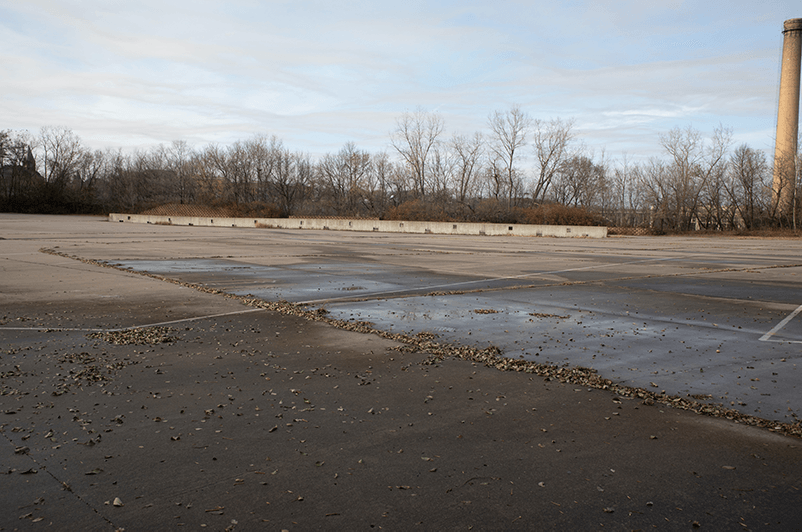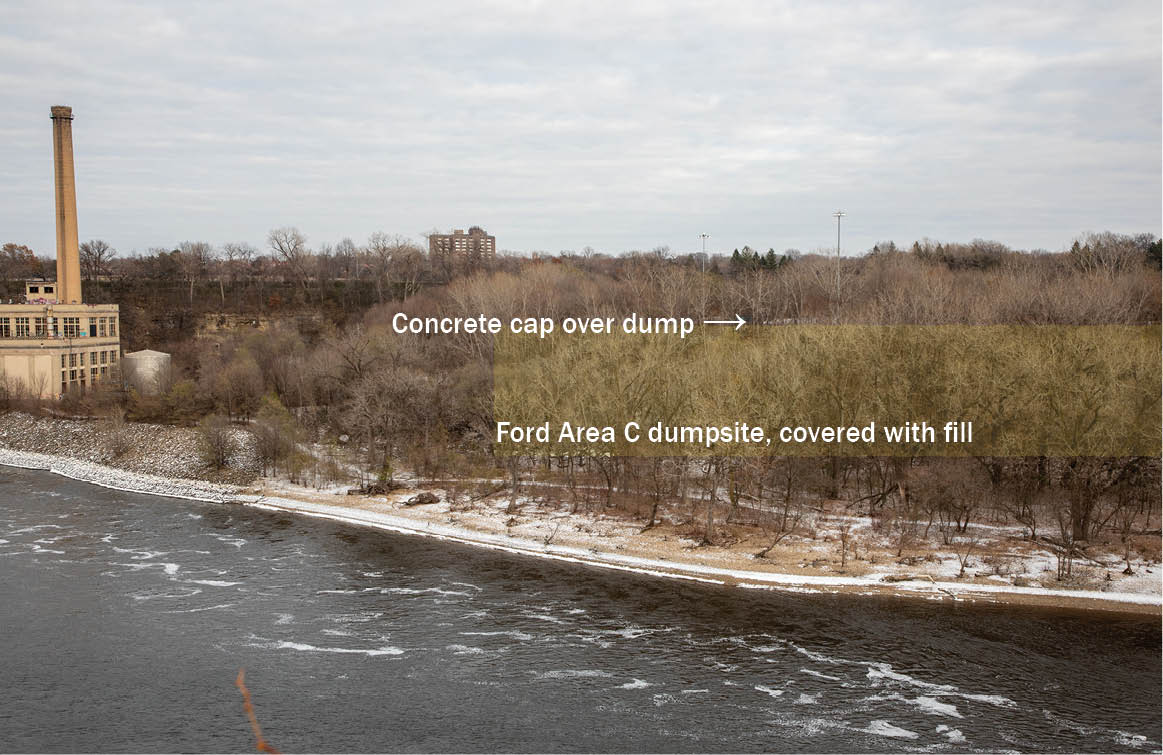Solar on the Area C dumpsite? Sounds great ... at first
The Ford Area C dump, the yellow-toned area, is a large pile that extends from the bluff towards the river just north of Hidden Falls Regional Park in St. Paul. Within it lie unknown quantities of toxic industrial waste. Two tall street lights can be seen where a solar array has been proposed atop the dump's concrete cap.
The main Ford Motor Company Twin Cities Assembly Plant parcel has been cleaned up and is ready for redevelopment into a connected, livable, mixed-use neighborhood on 135 acres near the river in St. Paul. The city and the developer, Ryan Companies, have announced their plans for this "net-zero" development, meaning that buildings will be highly energy-efficient and will use renewable energy sources.
This emphasis on efficiency was one of the reasons FMR supported the Ford redevelopment plan overall. However, a small piece of this efficiency plan is now giving us cause for concern: A 7-acre array of solar panels.
It's not what's being built, but where and when that's at issue. The array is being proposed for the top of an unpermitted hazardous waste dump in the river's floodplain. If built too soon, construction could begin before the state and Ford have finished investigating what chemicals may be coming from the dump and how to protect our river and groundwater from them.
Studies are underway on how to best address pollution concerns at the old landfill known as Ford Area C, and excavation will be one of several options studied by the Minnesota Pollution Control Agency.
Would adding the array's infrastructure on top of the dump make it harder or more expensive to carry out any recommended cleanup? And would the small environmental benefit from the energy produced justify making it more difficult to address the potential environmental hazards at Area C?
While the idea of the array — which could be the largest in an urban area in Minnesota — is quite attractive, these are questions that deserve an answer. FMR believes the public should have a chance to explore the potential benefits and drawbacks to building a solar array on top of hazardous waste that is contaminating the river.
Further study of Area C coming
Area C is a waste dump on the floodplain of the Mississippi River below the bluff near the assembly plant. Ford dumped unknown quantities of hazardous industrial waste, such as solvents and paint sludge, onto Area C from the 1940s to 1960s and then covered the toxic dump with construction rubble. (Learn more about Area C.)
FMR and its partners, including the Capitol Region Watershed District, have been advocating for the Minnesota Pollution Control Agency (MPCA) to require Ford to do more thorough monitoring of ground and surface water flowing off of the waste pile for some time. Now that cleanup of the main redevelopment parcel has wrapped up, Ford and the MPCA have turned their attention to Area C. Recently, Ford agreed to install additional monitoring wells at the dumpsite.
Because the river interacts with the waste pile differently in different seasons, including flooding the hazardous waste in high-water conditions (which climate change is sure to bring more of), we think it's important to gather several months' data (including from multiple flood events) before coming to any conclusions about what, if any, risk Area C poses to the river and our community.
FMR and its partners have also asked Ford to test for PFAS (also known as PFCs), a class of chemicals increasingly understood to pose serious environmental and health threats. PFAS compounds have been nicknamed "forever chemicals" because they don't break down over time as some substances do.
As you may have seen in the news, the EPA is currently evaluating whether to set Safe Drinking Water Act limits for PFAS as well as whether to list some of the compounds as "hazardous" under the Superfund law, which would require that they be cleaned up when found at high levels.
Thanks to advocacy by FMR and our partners, the MPCA is now requiring Ford to begin PFAS monitoring at the site.
As testing results from the expanded monitoring network come in over the next one to two years, Ford and the MPCA will be working on a "feasibility study." The feasibility study will examine the results from the expanded monitoring network and, based on this better-informed assessment of the risks posed by Area C, lay out different options for site remediation.
These options may range from "no action" to full removal of the waste pile. The final remediation plan will be selected based on risk, cost, and community acceptance. MPCA staff have told us that they will require at least some cleanup or remediation.

The concrete pad or cap just west of Mississippi River Boulevard in St. Paul covers a hazardous waste dump known as Area C.
Too many questions to make a decision
We don't believe there should be a rush to build on a toxic dumpsite before we know the harm potentially caused by the site and how to best mitigate it. The city and Ryan Companies are proposing that the solar array be built on the concrete cap (often used as a parking lot) that is covering part of the waste pile.
When deciding if any remediation should take place, cost is factored in. Every new piece of infrastructure on top of the waste pile could increase the cost of digging into the pile to remove hazardous waste in the coming years.
Before anything is built, FMR would like to see further community involvement in this decision-making process. We'd like to explore the potential benefits and drawbacks to building a solar array on top of hazardous waste that we know is leaking waste into the river at some level.
Are there alternative locations for solar power that could serve the redevelopment site without complicating any future cleanup that might be needed? Could the Area C solar project be put on hold for one to two years until we know more about the risks posed by the waste dump?
Stay informed
At the request of FMR and our partners, the MPCA has agreed to hold a public meeting, now scheduled for February 20, 2020 from 6-8 p.m. At this meeting, they'll share more information about the groundwater monitoring Ford has carried out, the feasibility study and their response to the requests that FMR and others have made for further study of the site. Learn more about the event here.
If you'd like to receive a reminder e-mail about this meeting and other occasional Area C updates, please let us know. We'll be sure to inform our Area C email list if and when we know the answers to the questions posed above.
For more information about Area C in general, please visit fmr.org/ford or contact Colleen O'Connor Toberman, River Corridor Program Director, at ctoberman@fmr.org or 651.222.2193 x29.
